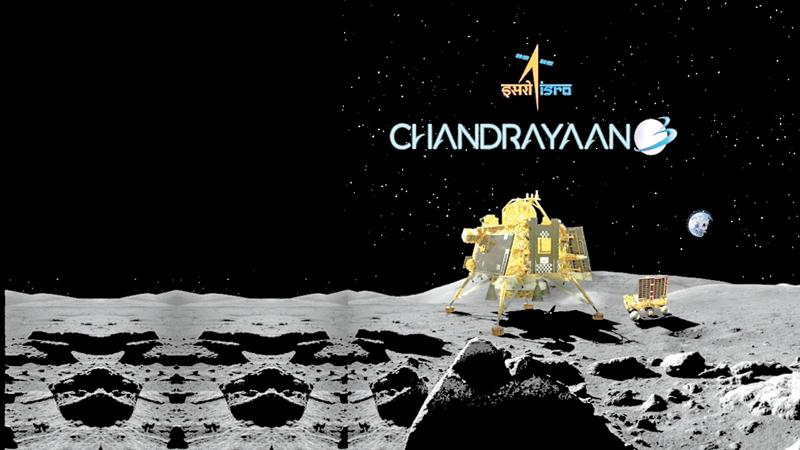
Chandrayan-3 successfully landed at the South Pole of the Moon, marking another victory for India’s Space Missions, which had its maiden success in 2008 sending Chandrayaan-1. The uniqueness of this triumph can be gauged from the fact that no other space power such as the USA, Russian Federation or China could land on the South Pole of the Moon and this achievement has certainly elevated the status of India into a global space power.
The path that India embraced for its triumphant moment did not arise out of the blue. It is an offshoot emanated from a long commitment and strategic planning that dates back to the first decade of India’s independence, when India’s first Prime Minister Jawaharlal Nehru determined to transform the nation into a global superpower based on its civilisational values. In the midnight of August 14, 1947 when India gained freedom from the British Empire, Nehru uttered his most prophetic words blended with poetry in a speech known as “Tryst with the destiny”.
In his historic address Nehru said: “A moment comes, which comes but rarely in history, when we step out from the old to the new, when an age ends and when the soul of a nation, long suppressed, finds utterance. It is fitting that at this solemn moment we take the pledge of dedication to the service of India”.
It took decades for India to reach the status of what Nehru aspired from the young nation through his lens of idealism, which was lampooned by many of the critiques of his day. India’s space journey began in 1962 and the Indian Space Research Organization (ISRO) conducted many space missions from a very routine level before it accomplished its lunar landing.
Race for supremacy
 At the launch of Chandrayaan-3 from the Satish Dhawan Space Centre
in Sriharikota. (ISRO)
|
Besides the grandeur and fame earned by the achievement of Chandrayan-3, this has certainly paved the path for a space race with China. The notion of space during the Cold War was determined by the systematic influence of superpower rivalry between the USA and the USSR and the present international order is akin to such competition as both India and China are involved in a race for supremacy.
China initiated its plans for space development in the wake of the First Gulf War by creating its satellite navigation system. China’s growing trepidation over the US space technology compelled Beijing to initiate its anti-satellite test in 2007. China had robust developments in its space domain under the China Manned Space Agency (CMSA).
Another crucial aspect of the Indo-China space race is the way they locate space in their strategic mechanisms in which India consolidates its space objectives around more traditional goals such as satellite launches, and sending humans to outer space. But, China’s space ambitions remain subtler in its outlook as it aims to extend its space systems beyond borders.
China’s space program is directly linked to the military strategy of the People’s Liberation Army (PLA). China’s 2021 white paper indicating the overall objectives of the Chinese space project defines Xi Jinping’s dream of transforming China into a first-rate space power and it has been bolstered by Beijing’s memorandum of understanding (MoU) with the Russian Federation to form a research station on the moon within the next two decades.
China constructed its space station the Tiangong orbital station with two laboratory modes-Wentian and Megtian. Also, another dominant factor that boosts China’s stance in space politics is the involvement of the commercial sector in space politics. Until now China has made massive investments in the space economy standing behind the USA and it is fair to assume the intensive commercialisation of space under Chinese commercial stakeholders is a sign that China plans to fulfill its economic goals.
Space race
The landing of Chandrayaan-3 on the moon is likely to escalate the space race between India and China to another stage. In particular, the norms created by the 1967 space treaty are at stake due to the intensified activities in outer space by State and non-State actors which alter the traditional balance of power shared between the USA and Russian Federation.
From a vantage point, India has attained the status of a global space power after its successful lunar mission, but the practical security dilemmas arising in the aftermath of the lunar landing mean that China is still ahead of the curve. It is in this context that we need to assess India’s current position as a global space power.
While keeping its civilizational ethos such as pacifism and humanity, Indian Premier Narendra Modi, speaking from Johannesburg where he was attending the BRICS Summit, hailed the success of Chandrayaan-3 as a victory for humankind, which is an indication that India’s space program is rooted in more peaceful objectives. In general, the achievement of India is worthy to admire beyond any conjecture. Nonetheless, the conspicuous geopolitical changes that erupted from Chandrayaan-3 will be more decisive in shaping the future global order.
India’s success in landing on the South Pole of the Moon will spur China’s space program to another competitive level. China is determined to send astronauts to the Moon before the end of the decade. This situation is a reminder of the Cold War rivalry between the USA and the Soviet Union.
There are complex geopolitical entanglements in South Asia, where India stands as a challenge to China’s rise and the Chinese-led Global Development Initiative. The space race between the two States is an addendum to the ongoing geopolitical rivalry and its possible consequences can have lasting effects on the whole South Asian region.
The author is a lecturer at the Faculty of Law, Sir John Kotelawala Defence University
